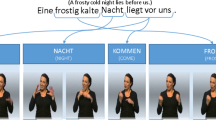Abstract
In this paper we describe an algorithm for generating distinctive behavior for Embodied Conversational Agents. To this aim, we introduce the concepts of agent’s general behavior tendency, named Baseline, and local behavior tendency, called in turn Dynamicline. Depending on the communicative intentions of the agent, the Baseline is modulated. The obtained behavior tendency corresponds to the Dynamicline which is then used to determine the nonverbal signals and their expressivity the agent will produce to communicate its intentions. We also propose a system to extract the movement expressivity of a human user standing in front of a camera. The extracted characteristics are then used to characterize the agent’s Baseline. We end the paper by presenting an evaluation study of our model.
Similar content being viewed by others
References
Allbeck J, Badler N (2003) Representing and parameterizing agent behaviors. In: Prendinger H, Ishizuka M (eds) Life-like characters: tools, affective functions and applications. Springer, Berlin
Allwood J (2002) Bodily communication - dimensions of expression and content. In: Granstrom B, House D, Karlsson I (eds) Multimodality in language and speech systems. Kluwer, Dordrecht, pp 7–26
Argyle M (1988) Bodily communication, 2nd edn. Methuen & Co, London
Badler N, Phillips C, Webber B (1993) Simulating humans: computer graphics animation and control. Oxford University Press, Oxford
Ball G, Breese J (2000) Emotion and personality in a conversational agent. In: Cassell J, Sullivan J, Prevost S, Churchill E (eds) Embodied conversational characters. MIT Press, Cambridge
Byun M, Badler N (2002) Facemote: qualitative parametric modifiers for facial animations. In: Proceedings of the 2002 ACM SIGGRAPH/Eurographics symposium on computer animation. ACM, New York, p 71
Caldognetto EM, Poggi I (2000) Dall’analisi della multimodalità quotidiana alla costruzione di facce parlanti. In: IV Conference of GFS (Gruppo di Fonetica Sperimentale). Padova, Italy
Camurri A, Mazzarino B, Volpe G (2004) Analysis of expressive gesture: The eyesweb expressive gesture processing library. In: Camurri A, Volpe G (eds) Gesture-based communication in human-computer interaction. LNAI, vol 2915. Springer, Berlin
Cassell J, Nakano YI, Bickmore TW, Sidner CL, Rich C (2001) Annotating and generating posture from discourse structure in embodied conversational agents. In: Workshop on representating, annotating, and evaluating non-verbal and verbal communicative acts to achieve contextual embodied agents. Montreal, Quebec
Cassell J, Sullivan J, Prevost S, Churchill E (2000) Embodied conversational agents. MIT Press, Cambridge
DeCarolis B, Pelachaud C, Poggi I (2000) Verbal and nonverbal discourse planning. In: Workshop on achieving human-like behaviors. Autonomous Agents
DeCarolis B, Pelachaud C, Poggi I, Steedman M (2004) APML, a mark-up language for believable behavior generation. In: Prendinger H, Ishizuka M (eds) Life-like characters, cognitive technologies. Springer, Berlin, pp 65–86
DiPaola S, Arya A (2004) Affective communication remapping in musicface system. In: Electronic imaging & visual arts
Egges A, Kshirsagar S, Magnenat-Thalmann N (2003) A model for personality and emotion simulation. In: Knowledge-based intelligent information and engineering systems. Springer, Berlin, pp 453–461
Ekman P, Friesen W, O’Sullivan M, Scherer K (1980) Relative importance of face, body, and speech in judgments of personality and affect. J Pers Soc Psychol 38:270–277
Gallaher PE (1992) Individual differences in nonverbal behavior: Dimensions of style. J Pers Soc Psychol 63(1):133–145
Hartmann B, Mancini M, Buisine S, Pelachaud C (2005) Design and evaluation of expressive gesture synthesis for embodied conversational agents. In: Third international joint conference on autonomous agents & multi-agent systems. Utretch
Kallmann M, Marsella S (2005) Hierarchical motion controllers for real-time autonomous virtual humans. In: Intelligent virtual agents. Springer, Berlin, pp 253–265
Kendon A (2004) Gesture: visible action as utterance. Cambridge University Press, Cambridge
Kipp M (2006) Creativity meets automation: Combining nonverbal action authoring with rules and machine learning. In: Intelligent virtual agents, pp 230–242
Kipp M, Neff M, Kipp KH, Albrecht I (2007) Towards natural gesture synthesis: Evaluating gesture units in a data-driven approach to gesture synthesis. In: Proceedings of the 7th international conference on intelligent virtual agents. Lecture notes in computer science, vol 4722. Springer, Berlin, pp 15–28
Kopp S, Wachsmuth I (2002) Model-based animation of coverbal gesture. In: Proceedings of computer animation, pp 252–257
Laban R (1971) The mastery of movement Plays. Inc, Boston
Lebourque T, Gibet S (1999) High level specification and control of communication gestures: the GESSYCA system. In: Proceedings of computer animation, vol 99
Lester J, Voerman J, Towns S, Callaway C (1997) Cosmo: A life-like animated pedagogical agent with deictic believability, pp 61–69
Mancini M, Pelachaud C (2007) Dynamic behavior qualifiers for conversational agents. In: Lecture notes in computer science, vol 4722. Springer, Berlin, p 112
Mancini M, Pelachaud C (2008) Distinctiveness in multimodal behaviors. In: Proceedings of the 7th international joint conference on autonomous agents and multiagent systems, pp 159–166
McNeill D (1992) Hand and mind: what gestures reveal about thought. University of Chicago Press, Chicago
Neff M, Fiume E (2004) Artistically based computer generation of expressive motion. In: Proceedings of the AISB symposium on language, speech and gesture for expressive characters, pp 29–39
Neff M, Fiume E (2005) AER: Aesthetic exploration and refinement for expressive character animation. In: Proceedings of the 2005 ACM SIGGRAPH/Eurographics symposium on computer animation. ACM Press, New York, pp 161–170
Neff M, Kim Y (2009) Interactive editing of motion style using drives and correlations. In: SCA ’09: Proceedings of the 2009 ACM SIGGRAPH/Eurographics symposium on computer animation. ACM, New York, pp 103–112
Neff M, Kipp M, Albrecht I, Seidel H (2008) Gesture modeling and animation based on a probabilistic re-creation of speaker style. ACM Trans Graph 27(1)
Niewiadomski R, Pelachaud C (2007) Intelligent expressions of emotions. In: Affective computing and intelligent interaction. Lecture Notes in Computer Science, vol 4738. Springer, Berlin, pp 12–23
Pelachaud C (2005) Multimodal expressive embodied conversational agents. In: MULTIMEDIA ’05: Proceedings of the 13th annual ACM international conference on multimedia. ACM Press, New York, pp 683–689
Poggi I (2007) Mind, hands, face and body. A goal and belief view of multimodal communication. Weidler, Berlin
Poggi I, Pelachaud C (2000) Performative facial expressions in animated faces. In: Embodied conversational agents. MIT Press, Cambridge, pp 155–188
Poggi I, Pelachaud C, Caldognetto EM (2003) Gestural mind markers in ECAs. In: Proceedings of the second international joint conference on Autonomous agents and multiagent systems. ACM Press, New York, pp 1098–1099
Reeves B, Nass C (1996) The media equation: How people treat computers, television and new media like real people and places. CSLI Publications, Stanford
Ruttkay Z, Pelachaud C, Poggi I, Noot H (2008) Exercises of style for virtual humans. In: Canamero L, Aylett R (eds) Animating expressive characters for social interactions. Benjamins, Amsterdam
Scherer KR, Wallbott HG (1985) Analysis of nonverbal behavior. Handbook of discourse analysis, vol 2, pp 199–230
Schröder M, Pirker H, Lamolle M (2006) First suggestions for an emotion annotation and representation language. In: Devillers, L, Martin, JC, Cowie, R, Douglas-Cowie, E, Batliner, A (eds) Proceedings of the international conference on language resources and evaluation: workshop on corpora for research on emotion and affect, pp 88–92. Genova, Italy
Vilhjaĺmsson H, Cantelmo N, Cassell J, Chafai NE, Kipp M, Kopp S, Mancini M, Marsella S, Marshall AN, Pelachaud C, Ruttkay Z, Thoŕisson KR, van Welbergen H, van der Werf R (2007) The behavior markup language: Recent developments and challenges. In: 7th international conference on intelligent virtual agents
Wallbott HG (1998) Bodily expression of emotion. Eur J Soc Psychol 28:879–896
Wallbott HG, Scherer KR (1986) Cues and channels in emotion recognition. J Pers Soc Psychol 51(4):690–699
Zhao L, Badler N (2005) Acquiring and validating motion qualities from live limb gestures. Graph Models 67(1):1–16
Author information
Authors and Affiliations
Corresponding author
Rights and permissions
About this article
Cite this article
Mancini, M., Pelachaud, C. Generating distinctive behavior for Embodied Conversational Agents. J Multimodal User Interfaces 3, 249–261 (2009). https://doi.org/10.1007/s12193-010-0048-y
Received:
Accepted:
Published:
Issue Date:
DOI: https://doi.org/10.1007/s12193-010-0048-y




